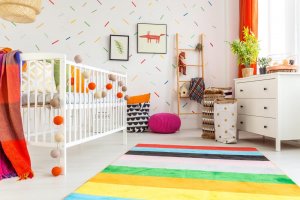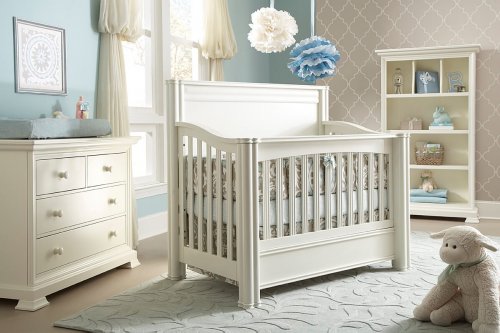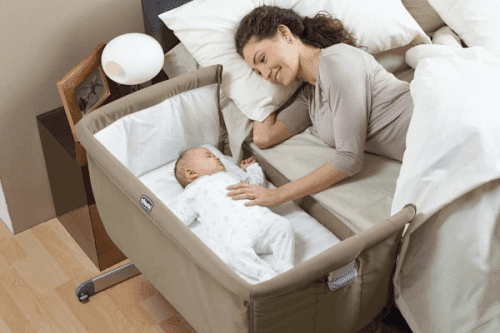6 Types of Cribs for Babies: How to Choose?

In the first years of life, little ones spend many hours asleep and rest is fundamental to their health. That’s why it’s essential to know how to choose between the different types of cribs for babies that are available.
During pregnancy, and perhaps also in the first months of your baby’s life, you must invest in several items, clothing and furniture for his or her upbringing.
Among these, the crib plays a fundamental role. It will be one of the elements that your little one uses the most and that will affect his or her quality of life. How do you choose the right one?
Types of cribs for babies: how to choose?
Among the various details that we must take into account when choosing a crib are the following:
- Size
- Comfort
- Security
- Adaptability to home environments
- Lifespan (for the baby’s growth)
- Price
- Material and quality of it
6 types of cribs for babies
1. Co-sleeping cots
These have three handrails: one on the back, another at the feet and the last one on the side. The uncovered side, meanwhile, should be placed facing the mother’s bed.
It’s an ideal crib for the first months of life. The baby doesn’t miss out on necessary contact with the mother, and she doesn’t sacrifice comfort for rest. This, in fact, is essential to maintain your health and to take advantage of opportunities to sleep.
Co-sleeping cots are of medium size because they’re intended for babies just a few months old. Generally, they have a system that allows you to attach them to your own bed, and the height can be adjusted.

2. Functional crib
Today, one of the most acclaimed alternatives in terms of types of cribs for babies is the functional crib. In addition to being safe, they have drawers on the lower part under the mattress and in the backrest.
They’re a great way to save space and, therefore, money. When you have a baby, you’ll realize that any storage space is worth its weight in gold. These cribs are ideal for storing clothes, changing tables, diapers and also toys. In fact, some include a changer on top of the drawers.
3. Classic crib
In this case, we refer to the classic wooden cradle that we’ve all seen time and again. Their main benefit is that they have a lifespan of many years. If you intend to have more than one child, they’re surely worth the investment.
On the other hand, they’re safe and comfortable. Many of them have removable bars that allow it to transform into a bed. Thus, your child’s progression from the crib to a bed will be more pleasurable for him.
For those who want to bring their children into their own bedrooms, there are many models with wheels. This allows you to move your baby’s crib without much effort. And most importantly: he won’t wake up!
“The cradle plays a fundamental role: it will be one of the elements your little one uses most and that affects his or her quality of life.”
4. Folding cribs
These types of cribs are ideal for travel. They fold down and are made with reinforced pipes that can be assembled at any time or dismantled for storage in a very practical case.
They come in different sizes, from bassinet cradles, which you can easily carry, or the traditional crib, which you can assemble in just minutes.
5. Convertible cribs
Currently, you can get cradles with rails and detachable heads that transform into a bed. The designs vary, and all are truly beautiful.
On the one hand, there are crib beds, which use the same mattress to form a crib with a seat behind the backrest. Or there are convertible cribs, which you can transform into a normal bed or sofa by just moving or removing its parts.

6. Practical cribs
As the name implies, these cradles stand out for their functionality. They’re made with waterproof fabric, which makes them easy to wash and very light to move.
In addition, they have mesh and rounded edges, so the child won’t have any risk of injury. They usually have a removable changer, and you can use them as a playpen for your baby.
As you can see, the types of cribs for babies are varied, and so are the designs, which are novel and eye-catching. All you have to do now is evaluate each option based on the points detailed in the beginning, and that’s it: you’ll have your baby’s resting place solved!
In the first years of life, little ones spend many hours asleep and rest is fundamental to their health. That’s why it’s essential to know how to choose between the different types of cribs for babies that are available.
During pregnancy, and perhaps also in the first months of your baby’s life, you must invest in several items, clothing and furniture for his or her upbringing.
Among these, the crib plays a fundamental role. It will be one of the elements that your little one uses the most and that will affect his or her quality of life. How do you choose the right one?
Types of cribs for babies: how to choose?
Among the various details that we must take into account when choosing a crib are the following:
- Size
- Comfort
- Security
- Adaptability to home environments
- Lifespan (for the baby’s growth)
- Price
- Material and quality of it
6 types of cribs for babies
1. Co-sleeping cots
These have three handrails: one on the back, another at the feet and the last one on the side. The uncovered side, meanwhile, should be placed facing the mother’s bed.
It’s an ideal crib for the first months of life. The baby doesn’t miss out on necessary contact with the mother, and she doesn’t sacrifice comfort for rest. This, in fact, is essential to maintain your health and to take advantage of opportunities to sleep.
Co-sleeping cots are of medium size because they’re intended for babies just a few months old. Generally, they have a system that allows you to attach them to your own bed, and the height can be adjusted.

2. Functional crib
Today, one of the most acclaimed alternatives in terms of types of cribs for babies is the functional crib. In addition to being safe, they have drawers on the lower part under the mattress and in the backrest.
They’re a great way to save space and, therefore, money. When you have a baby, you’ll realize that any storage space is worth its weight in gold. These cribs are ideal for storing clothes, changing tables, diapers and also toys. In fact, some include a changer on top of the drawers.
3. Classic crib
In this case, we refer to the classic wooden cradle that we’ve all seen time and again. Their main benefit is that they have a lifespan of many years. If you intend to have more than one child, they’re surely worth the investment.
On the other hand, they’re safe and comfortable. Many of them have removable bars that allow it to transform into a bed. Thus, your child’s progression from the crib to a bed will be more pleasurable for him.
For those who want to bring their children into their own bedrooms, there are many models with wheels. This allows you to move your baby’s crib without much effort. And most importantly: he won’t wake up!
“The cradle plays a fundamental role: it will be one of the elements your little one uses most and that affects his or her quality of life.”
4. Folding cribs
These types of cribs are ideal for travel. They fold down and are made with reinforced pipes that can be assembled at any time or dismantled for storage in a very practical case.
They come in different sizes, from bassinet cradles, which you can easily carry, or the traditional crib, which you can assemble in just minutes.
5. Convertible cribs
Currently, you can get cradles with rails and detachable heads that transform into a bed. The designs vary, and all are truly beautiful.
On the one hand, there are crib beds, which use the same mattress to form a crib with a seat behind the backrest. Or there are convertible cribs, which you can transform into a normal bed or sofa by just moving or removing its parts.

6. Practical cribs
As the name implies, these cradles stand out for their functionality. They’re made with waterproof fabric, which makes them easy to wash and very light to move.
In addition, they have mesh and rounded edges, so the child won’t have any risk of injury. They usually have a removable changer, and you can use them as a playpen for your baby.
As you can see, the types of cribs for babies are varied, and so are the designs, which are novel and eye-catching. All you have to do now is evaluate each option based on the points detailed in the beginning, and that’s it: you’ll have your baby’s resting place solved!
This text is provided for informational purposes only and does not replace consultation with a professional. If in doubt, consult your specialist.








